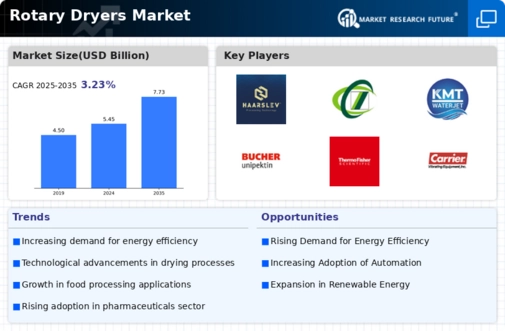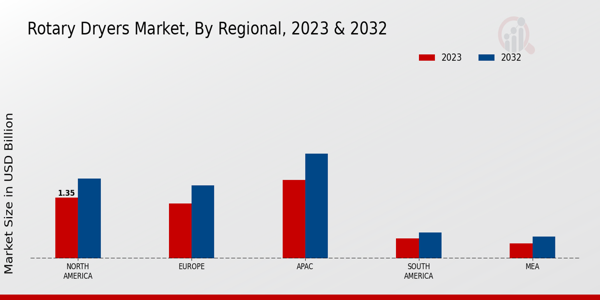Market Growth Projections
The Global Rotary Dryers Market Industry is poised for substantial growth, with projections indicating a market size of 5.45 USD Billion in 2024 and an anticipated increase to 7.73 USD Billion by 2035. This growth trajectory reflects a compound annual growth rate (CAGR) of 3.23% from 2025 to 2035, driven by various factors including technological advancements, increasing industrial applications, and a focus on energy efficiency. The market dynamics suggest a robust demand for rotary dryers across multiple sectors, highlighting their critical role in enhancing processing efficiency and product quality. As industries continue to evolve, the rotary dryer market is likely to adapt and thrive.
Technological Advancements
Technological advancements play a crucial role in shaping the Global Rotary Dryers Market Industry. Innovations such as improved heat transfer mechanisms and automation in drying processes enhance efficiency and reduce energy consumption. For example, the integration of advanced control systems allows for precise monitoring and adjustment of drying parameters, resulting in better product quality and reduced operational costs. As industries increasingly prioritize sustainability and energy efficiency, the demand for technologically advanced rotary dryers is likely to rise. This trend aligns with the projected CAGR of 3.23% from 2025 to 2035, indicating a robust growth trajectory driven by continuous improvements in dryer technology.
Rising Demand in Agriculture
The Global Rotary Dryers Market Industry experiences a notable surge in demand driven by the agricultural sector. As farmers increasingly seek efficient methods to dry grains, fruits, and vegetables, rotary dryers emerge as a preferred choice due to their ability to handle large volumes and provide uniform drying. This trend is particularly evident in regions with significant agricultural output, where the need for post-harvest processing is paramount. The market is projected to reach 5.45 USD Billion in 2024, reflecting the growing reliance on rotary dryers to enhance product quality and reduce spoilage, thereby supporting food security initiatives globally.
Industrial Applications Expansion
The Global Rotary Dryers Market Industry benefits from the expansion of industrial applications across various sectors, including mining, chemicals, and pharmaceuticals. Industries are increasingly adopting rotary dryers for their versatility in handling different materials and their efficiency in moisture removal. For instance, in the mining sector, rotary dryers are utilized to process minerals and ores, enhancing product quality and operational efficiency. This diversification of applications is expected to contribute to the market's growth, with projections indicating a rise to 7.73 USD Billion by 2035. The continuous innovation in rotary dryer technology further supports this trend, enabling industries to optimize their drying processes.
Growing Focus on Energy Efficiency
The Global Rotary Dryers Market Industry is significantly influenced by the growing focus on energy efficiency across various sectors. Industries are increasingly seeking drying solutions that minimize energy consumption while maximizing output. Rotary dryers, known for their ability to operate efficiently under varying conditions, are becoming a preferred choice. This shift is particularly relevant in energy-intensive industries, where operational costs are a major concern. As companies strive to meet sustainability goals, the demand for energy-efficient rotary dryers is expected to rise, contributing to the overall market growth. The emphasis on reducing carbon footprints further supports this trend, aligning with global sustainability initiatives.
Regulatory Support for Manufacturing
Regulatory support for manufacturing processes is a key driver of the Global Rotary Dryers Market Industry. Governments worldwide are implementing policies that encourage the adoption of advanced drying technologies to improve product quality and safety. This regulatory environment fosters innovation and investment in rotary dryer technologies, as manufacturers seek to comply with stringent quality standards. For instance, regulations aimed at reducing waste and enhancing energy efficiency are prompting industries to upgrade their drying systems. This supportive framework is likely to bolster market growth, as companies invest in rotary dryers that meet regulatory requirements while enhancing operational efficiency.












